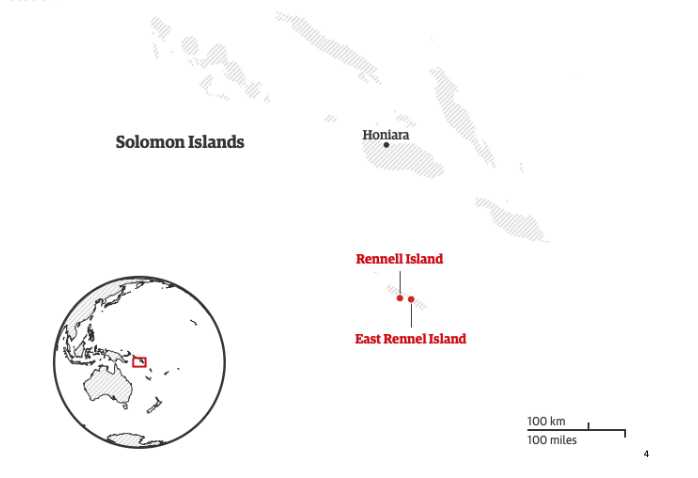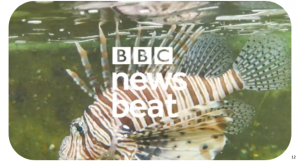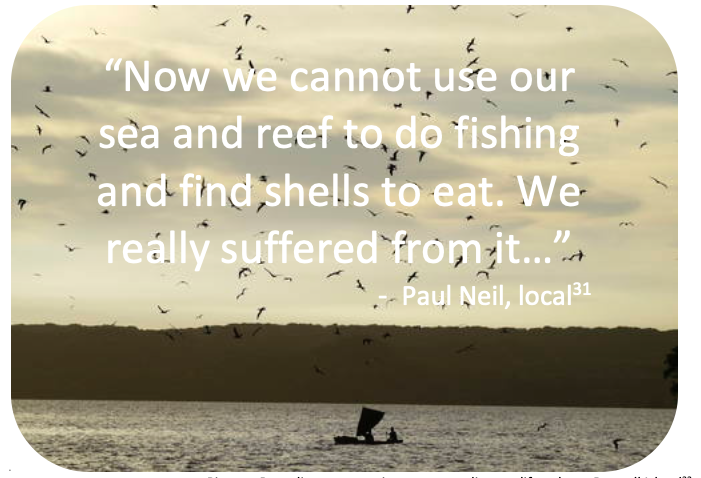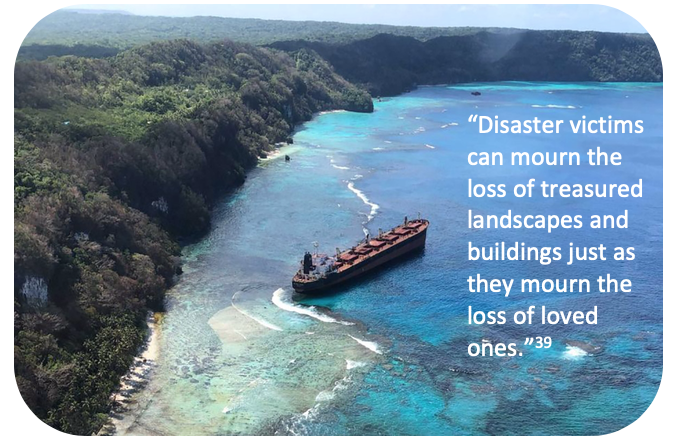MV Solomon Trader Oil Spill: A Crude Attempt at Disaster Recovery
This blog has been written by Christina Wilson on the MV Solomon Trader Oil Spill. It was judged to be one of two blogs which were amongst the highest calibre for the whole cohort in the Culture and Disasters Module (MSc International and Disaster Management program)
In the middle of the night on February 4th, 2019, a Hong Kong registered bulk carrier ran aground in rough seas and high winds off the coast of Rennell Island in the Solomon Islands and begun to leak crude oil. The remoteness and inaccessibility of Rennell would have made any response difficult but the disaster was exacerbated by the impact of category two Cyclone Oma which made landfall almost simultaneously.
Location:
The Solomon Islands extend over 1450 kilometres in Pacific Melanesia, accounting for 28,785 squared kilometres of land, approximately the size of Maryland, USA. The Solomon Islands are considered to be a Small Island Developing State (SIDS) by the United Nations and extremely vulnerable to climate change and disasters. Collectively, the Solomon Islands are culturally distinct, surrounded by a diverse and complex coastal and marine ecosystem. The governance of the Islands, the isolation, the environment, and the influence of international actors, including UNESCO, are all important factors to consider when looking at this recent Rennell oil spill and the beginning of the recovery process.
But in this case, what is recovery? And with only the small population of Rennell Island affected, does this oil spill constitute a disaster worthy of international support and scrutiny? What should local, national, and international stakeholders be doing? What does recovery look like for the Rennellese?
This disaster is not an opportunity to ‘develop’, ‘build back better’, or ‘bounce forward’; it was an irresponsible industrial accident with grave consequences for the environment and the people of Rennell Island. As the response stage of this disaster winds down we must try to understand what recovery looks like in this compounded industrial accident, within the unique cultural context of the Solomon Islands.
Industrial Accident Recovery
Tierney and Oliver-Smith argue that recovery from technological or industrial accidents are “…more complicated because the effects of technological disasters are difficult to determine, leading to higher levels of stress, and because technological events are often followed by community conflict, litigation, and other stressors.” As the graph below demonstrates, there has been a steady decline in the number of oil spills internationally; however more attention is needed as the world has become increasingly ecologically vulnerable.
The environment surrounding a small-moderate spill similar to Rennell, off the coast of Australia, has not recovered more than four years later despite the best efforts of multiple stakeholders. It is essential for all stakeholders to acknowledge the potential longevity and cultural impacts of this spill, with a longitudinal assessment. Currently, it is unclear how deeply this disaster will affect the Rennellese; nevertheless, it is essential for stakeholders to look to previous disasters such as the Exxon Valdez, and Deepwater Horizon, to help create an effective recovery plan for Rennell and future oil related disasters
Cultural Context of a Solomon Island Recovery
It is likely that more than 80% of the Rennellese “… are wholly or partly dependent on subsistence farming and fishing”.The pre-disaster community was already dealing with declining fish stocks and general food insecurity as very little cassava, sugar cane, and other crops grow sustainably. Rennell Island was a fishing community reliant on the sea for individual livelihoods and the survival of their families. Yet nothing has been done to encourage their recovery or the cultural resilience of the fishing community post-oil spill.
The Rennellese who have lost their livelihood can experience hopelessness and depression, along with ‘secondary trauma’ from litigation, as previous victims of oil spills have experienced. As Quarantelli believes, there must be a focus on the ripple or secondary effects of a disaster within the recovery process.A significant and sizeable portion of the population suffered adverse mental health effects after Deepwater Horizon, which could also be easily expected with a less commercial, more sustenance-fishing population like Rennell. Disaster survivors that have witnessed the ecological destruction of their land, sea, or livelihood have been known to seek clinical mental health services, and healthcare professionals need to be versed in the human impacts of ecological trauma.[v] It is also crucial to consider that post-oil spill intimate partner violence (IPV) can drastically increase. Focusing on community strength and resilience can not only help the collective but also the individual, as the more resilient a community the less affected an individual by disaster or loss of livelihood.
Social attachment to a physical location makes social recovery more difficult, and the drastically altered ecological environment, contamination, and economic pressures may force some Rennellese to relocate. The Solomon Islands have previously seen the successful relocation of two villages on Rongha Islands through adopting a pro-community and pro-active approach post-earthquake in 2007, where 80% of villages voluntarily relocated. Nevertheless, there is a call for a more formidable governance framework around relocation to protect human and land rights in the Solomon Islands. Furthermore, success may be limited by heterogeneity among Islanders. Any recovery in the Solomon Islands needs extensive contextualisation and localisation, along with sensitivity and understanding of the social capital of the affected area. This includes an understanding of the wantok system of ethnic, geographical, tribal, and linguistic groupings in Melanesia that allows for the promotion of social cohesion and equality. Any theoretical best practice of recovery must include the role of cultural heritage in the reconstruction of individual and communal identity, which is extremely important for the Rennellese.
Concluding the Clean Up and Fuelling the Future
Every successfully recovery begins with an effective response. During this oil spill the Australian government was called in to provide response and recovery. There is a dire need for increased professionalisation in the disaster management and resilience sectors within the Solomon Islands, so this and future disasters can be managed by local actors.Indigenous knowledge helped many Solomon Islanders during past disasters, but this oil spill, a modern technological disaster, calls for innovation in mitigation to combat modern hazards. As the Solomon Islands, and the Pacific are ‘acutely vulnerable’ to climate change related disasters,more has to be done to mitigate industrial and technological disasters to prevent further strain on the already stretched system.
References:
Abramson, D.M., Grattan, L.M., Mayer, B., Colten, C.E., Arosemena, F.A., Bedimo-Rung, A. and Lichtveld, M., 2015. The resilience activation framework: a conceptual model of how access to social resources promotes adaptation and rapid recovery in post-disaster settings. The journal of behavioral health services & research, 42(1), pp.42-57.
Albert, S., Aswani, S., Fisher, P.L. and Albert, J., 2015. Keeping food on the table: human responses and changing coastal fisheries in Solomon Islands. PloS one, 10(7).
Albert, S., Bronen, R., Tooler, N., Leon, J., Yee, D., Ash, J., Boseto, D. and Grinham, A., 2018. Heading for the hills: climate-driven community relocations in the Solomon Islands and Alaska provide insight for a 1.5 C future. Regional environmental change, 18(8), pp.2261-2272.
Archer, D. and Boonyabancha, S., 2011. Seeing a disaster as an opportunity–harnessing the energy of disaster survivors for change. Environment and Urbanization, 23(2), pp.351-364.
Bell J, Taylor M, Amos M, Andrew N. 2016. Climate change and Pacific Island food systems. CCAFS and CTA. Copenhagen, Denmark and Wageningen, the Netherlands. Available at: https://cgspace.cgiar.org/bitstream/handle/10568/75610/Pacific%20Booklet%20Final%20web.pdf?sequence=6 (Accessed 27 March, 2019).
Bevege, A., 2019. “Australia sends more help for Solomon Islands oil spill”. Reuters. 3 March. Available at: https://af.reuters.com/article/worldNews/idAFKCN1QK05H (Accessed 27 March, 2019).
Chandra, A. and Acosta, J.D., 2010. Disaster recovery also involves human recovery. JAMA, 304(14), pp.1608-1609.
CIA. 2019. Australia – Oceania: Solomon Islands. Available at: https://www.cia.gov/library/publications/the-world-factbook/geos/bp.html (Accessed 27 March, 2019).
Clarke, H.E. and Mayer, B., 2017. Community recovery following the Deepwater horizon oil spill: Toward a theory of cultural resilience. Society & natural resources, 30(2), pp.129-144.
Drescher, C.F., Baczwaski, B.J., Walters, A.B., Aiena, B.J., Schulenberg, S.E. and Johnson, L.R., 2012. Coping with an ecological disaster: The role of perceived meaning in life and self-efficacy following the Gulf oil spill. Ecopsychology, 4(1), pp.56-63.
Finlayson, K., Stevens, T., Arthur, J.M. and Rissik, D., 2015. Recovery of a subtropical rocky shore is not yet complete, four years after a moderate sized oil spill. Marine pollution bulletin, 93(1-2), pp.27-36.
Fritz, H.M. and Kalligeris, N., 2008. Ancestral heritage saves tribes during 1 April 2007 Solomon Islands tsunami. Geophysical Research Letters, 35(1).
Gillespie, R.G. and Clague, D.A. eds., 2009. Encyclopedia of islands (No. 2). University of California Press.
Handmer, J. and Nalau, J., 2019. Understanding loss and damage in Pacific Small Island developing states. Loss and Damage from Climate Change, pp.365-381.
Hemstock, S.L., Des Combes, H.J., Buliruarua, L.A., Maitava, K., Senikula, R., Smith, R. and Martin, T., 2018. Chapter 14 Professionalising the ‘resilience’ sector in the Pacific Islands region. A Critical Approach to Climate Change Adaptation: Discourses, Policies and Practices.
ITOPF. 2019. Oil Tanker Spill Statistics 2018. ITOPF Limited. Available at: https://www.itopf.org/fileadmin/data/Documents/Company_Lit/Oil_Spill_Stats_2019.pdf (Accessed 27 March, 2019).
Jenner, L. 2019. “Oma (Southern Pacific Ocean)”. NASA. Available at: https://blogs.nasa.gov/hurricanes/tag/oma-2019/ (Accessed 27 March 2019).
Julca, A. and Paddison, O., 2010. Vulnerabilities and migration in Small Island Developing States in the context of climate change. Natural Hazards, 55(3), pp.717-728.
Jupiter, S., McCarter, J., Albert, S., Hughes, A. and Grinham, A., 2019. Solomon Islands: Coastal and Marine Ecosystems. World Seas: an Environmental Evaluation, pp.855-874.
Kelman, I., 2015. Disaster risk governance for Pacific island communities. The Asia-Pacific Journal: Japan Focus, 13(48).
Kelman, I., 2017. How can island communities deal with environmental hazards and hazard drivers, including climate change?. Environmental Conservation, 44(3), pp.244-253.
Lauve-Moon, K. and Ferreira, R.J., 2017. An exploratory investigation: Post-disaster predictors of intimate partner violence. Clinical social work journal, 45(2), pp.124-135.
Manyena, B., O’Brien, G., O’Keefe, P. and Rose, J., 2011. Disaster resilience: a bounce back or bounce forward ability?. Local Environment: The International Journal of Justice and Sustainability, 16(5), pp.417-424.
Martin, L. 2019a. “Bulk carrier leaking oil on Solomons Islands reef after running aground”. The Guardian, 19 February. Available at: https://www.theguardian.com/world/2019/feb/19/fears-of-enviromental-disaster-after-bulk-carrier-runs-aground-on-solomon-islands-reef-spilling-oil (Accessed 27 March, 2019).
Martin, L. 2019b. “Solomon Islands oil spill: currents push slick away from world heritage site”. The Guardian, 26 March. Available at: https://www.theguardian.com/world/2019/mar/26/solomon-islands-oil-spill-currents-push-slick-away-from-world-heritage-reef (Accessed 27 March, 2019).
McAdoo, B.G., Moore, A. and Baumwoll, J., 2009. Indigenous knowledge and the near field population response during the 2007 Solomon Islands tsunami. Natural Hazards, 48(1), pp.73-82.
McCandless-Farmer, B., 2019. “Remembering the Exxon Valdez oil spill 30 years later”. CBS News, 24 March. Available at: https://www.cbsnews.com/news/remembering-the-exxon-valdez-oil-spill-30-years-later-60-minutes/ (Accessed 27 March, 2019).
Mitchell, J.K., 1996. The long road to recovery: Community responses to industrial disaster. United Nations University.
Nanau, G.L., 2011. The wantok system as a socio-economic and political network in Melanesia. OMNES: The Journal of Multicultural Society, 2(1), pp.31-55.
Noy, I., 2016. Natural disasters in the Pacific Island Countries: new measurements of impacts. Natural Hazards, 84(1), pp.17.
Ocean Portal Team. 2018. “Gulf Oil Spill”. Smithsonian. Available at: https://ocean.si.edu/conservation/pollution/gulf-oil-spill (Accessed 27 March, 2019).
Osifelo, E., and Martin L., 2019 “’We cannot swim, we cannot eat’: Solomon Islands struggle with nation’s worst oil spill”. The Guardian, 6 March. Available at: https://www.theguardian.com/environment/2019/mar/06/solomon-islanders-suffer-worst-oil-spill-nations-history-bulk-carrier-bauxite (Accessed 27 March, 2019).
Otoara Ha’apio, M., Wairiu, M., Gonzalez, R. and Morrison, K., 2018. Transformation of rural communities: lessons from a local self-initiative for building resilience in the Solomon Islands. Local Environment, 23(3), pp.352-365.
Our Place. n.d. East Rennell (Solomon Islands). UNESCO [Picture]. Available at: whc.unesco.org/en/documents/123703 (Accessed 27 March, 2019).
Quarantelli, E.L., 1998. Disaster recovery: Research based observations on what it means, success and failure, those assisted and those assisting. US University of Delaware. Disaster Research Center (DRC), US.
Picou, J.S., Gill, D.A., Dyer, C.L. and Curry, E.W., 1992. Disruption and stress in an Alaskan fishing community: Initial and continuing impacts of the Exxon Valdez oil spill. Industrial Crisis Quarterly, 6(3), pp.235-257.
Ritchie, L.A., Gill, D.A. and Picou, J.S., 2011. The BP disaster as an Exxon Valdez rerun. Contexts, 10(3), pp.30-35.
Russell, M., 2019. “Solomon Islands still at threat from oil spill”. Geographical. 18 March. Available at: https://geographical.co.uk/nature/oceans/item/3144-oil-spill (Accessed 23 March 2019).
Schuermann, S., 2013. The wantok system, scale and vulnerability: Shaping disaster recovery in an immigrant community of the Western Solomon islands (Doctoral dissertation, San Diego State University).
Shepard, P.J. and Walter, R., 2006. A revised model of Solomon Islands culture history. Journal of the Polynesian Society, The, 115(1).
Tierney, K. and Oliver-Smith, A., 2012. Social Dimensions of Disaster Recovery. International Journal of Mass Emergencies & Disasters, 30(2).
United Nations. 2019. “Small Island Developing States”. UN. Available at: https://sustainabledevelopment.un.org/topics/sids/list (Accessed 21 March, 2019).
United Nations Educational, Scientific and Cultural Organization (UNESCO). 2019. “Concern for oil spill in East Rennell, Solomon Islands, in central Pacific.” UNESCO. Available at: https://whc.unesco.org/en/news/1934 (Accessed 21 March 2019).
United Nations General Assembly. 2016. “Report of the Open-Ended Intergovernmental Expert Working Group on Indicators and Terminology Relating to Disaster Risk Reduction.” UN. Available at: https://www.preventionweb.net/files/50683_oiewgreportenglish.pdf (Accessed 21 March, 2019).
United Nations Office for Disaster Risk Reduction (UNISDR). 2017. “Build Back Better in recovery, rehabilitation and reconstruction.” UNISDR. Available at: https://www.unisdr.org/files/53213_bbb.pdf (Accessed 21 March 2019).
The World Bank. 2009. “Reducing the Risk of Disasters and Climate Variability in the Pacific Islands : Solomon Islands Country Assessment.” UN. Available at: https://sustainabledevelopment.un.org/content/documents/1325solomonDisaster%20Management%20Strategy.pdf (Accessed 25 March, 2019).










0 Comments